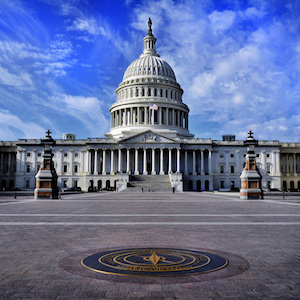In a positive sign that lawmakers are committed to fixing several errors contained in the SECURE 2.0 Act, the House and Senate have just released a draft technical corrections bill, including changes to allow catch-up contributions and provide parity for Starter 401(k)s championed by the American Retirement Association (ARA).
In the Senate, the technical corrections draft was released by Senate Committee on Health, Education, Labor and Pensions Chair Bernie Sanders (D-VT) and Ranking Member Bill Cassidy (R-LA) along with Senate Finance Committee Chair Ron Wyden (D-OR) and Ranking Member Mike Crapo (R-ID). Likewise, House Ways and Means Committee Chair Jason Smith (R-MO) and Ranking Member Richard Neal (D-MA), along with Education and the Workforce Committee Chairwoman Virginia Foxx (R-NC) and Ranking Member Bobby Scott (D-VA) released an identical measure in the House.
“ARA really appreciates the tremendously hard work of all the congressional committee staff in putting this package of technical corrections together,” ARA CEO Brian Graff said. "In particular, we are very pleased they agreed that the Starter K contribution limit was always intended to track with the IRA contribution limit and that the proposal will correct this technical error."
The 16-page bill is divided into three sections, including technical amendments, clerical amendments (usually to fix minor word errors), and other clarifications.
Key Provisions
Shortly after enactment of SECURE 2.0, the ARA identified several provisions that needed fixing, and alerted the relevant staff at the Treasury Department and Congress’ Joint Committee on Taxation. Some mistakes were identified immediately or were known about in advance, while others did not become apparent until the ARA’s legal counsel dug into the fine print of the legislation.
Catch-up contributions (Section 603 of SECURE 2.0). One such provision was what the ARA called a “significant technical error” regarding catch-up contributions under Section 603 of the legislation, such that the changes would essentially result in no participants being able to make catch-up contributions beginning in 2024. The snafu apparently was the result of the elimination of a subparagraph in the body of the legislation to allow for a conforming amendment—but in the process inadvertently eliminated the ability to make any pre-tax catch-up contributions. The draft technical correction legislation now fixes that error.
To help alleviate the issue, the IRS in August released guidance that addressed Section 603 of the SECURE 2.0 Act by granting a two-year delay in the provision's effective date that mandates catch-up contributions must be Roth for those earning more than $145,000. More specifically, catch-up contributions can now be made on a pre-tax basis through 2025, regardless of income.
Starter 401(k) (Section 121): Another win for the ARA is a change to fix an inadvertent error involving the contribution limit for the new Starter 401(k)s. A summary by the Senate Finance Committee reflected an intent for the contribution limits of the Starter 401(k)/403(b) plans to be the same as the contribution limit for IRAs. However, the provision limited contributions to $6,000 (indexed), which is the 2022 limit and is lower than what the IRA limit will be in 2024.
In short, the technical correction legislation strikes the reference to $6,000 and inserts text specifying that the contribution limit is “the amount in effect under section 219(b)(1)(A) for the taxable year in which the calendar year begins,’’ such that the contribution limit would now be tied to the IRA contribution limit.
Other Changes
Additional SECURE 2.0 provisions that the draft legislation seeks to fix include, among others:
- Expanding automatic enrollment in retirement plans (Section 101)
- Modification of the credit for small employer pension plan startup costs (Section 102)
- Saver’s Match (Section 103)
- Increase in age for required beginning date for mandatory distributions (Section 107)
- Higher catch-up limit to apply at age 60, 61, 62, and 63 (Section 109)
- Treatment of student loan payments as elective deferrals for purposes of matching contributions (Section 110)
- Improving coverage for part-time workers (Section 125)
- Special rules for certain distributions from long-term qualified tuition programs to Roth IRAs (Section 126)
- Retirement savings lost and found (Section 303)
- SIMPLE and SEP Roth IRAs (Section 601)
- Enhancing retiree health benefits in pension plans (Section 606)
The technical corrections legislation has been in the works for quite some time, as the tax-writing committee chairmen and ranking members alerted the Treasury Department and IRS in May that they plan to introduce legislation to fix several errors contained in SECURE 2.0. In the letter signed by Ways and Means Chairman Smith, Ranking Member Neal, Senate Finance Committee Chairman Wyden, and Ranking Member Crapo, the lawmakers specifically highlighted Sections 102, 107, 601 and 603 as needing fixing.
Note that the technical fixes are not intended to alter the underlying policies in any way. To that end, most of the changes made by the legislation would be effective as if included in the SECURE 2.0 Act when enacted in 2022, while others would become effective on the date of enactment of the technical corrections legislation.
Next Steps
The chairman and ranking members have now asked stakeholders to review the legislation and offer any feedback to their respective committees.
Typically, a year-end omnibus spending bill to fund the federal government would be the targeted legislative vehicle, but Congress recently approved legislation that temporarily funds the federal government until January. It’s possible this legislation could be attached to a funding bill early next year. But given the significance of some of the errors, there could be more urgency to resolve the various issues before the start of 2024.
The full text of the discussion draft can be found here.
- Log in to post comments
